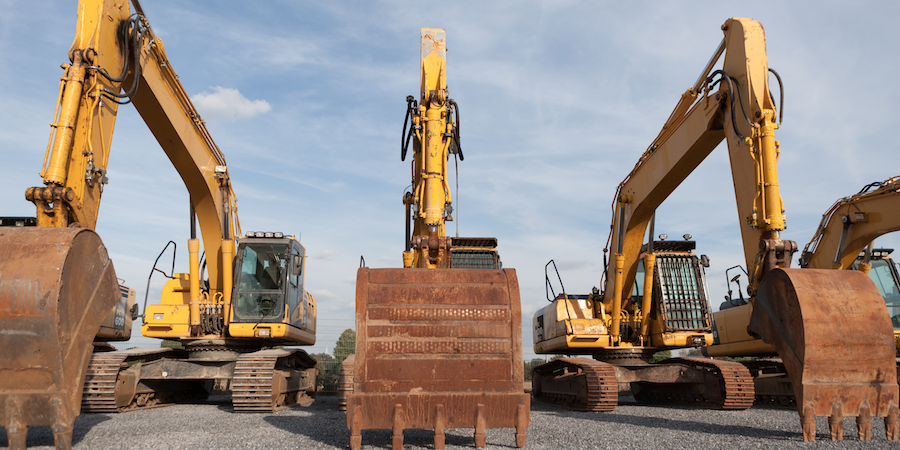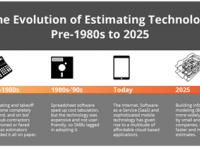It was a really quiet and dark night when I stepped onto the ball and hook on the massive crane that would be delivering concrete mix for the spillway intake for the dam we were building. The spillway intake chamber was 400 feet in the ground and I had already been down there on a previous night to watch as the wooden forms and rebar cages were being put into place under the bright lights. Tonight, I was about to have the ride of my life, one that the safety engineer would frown upon, but which would make a life memory for me.The crane operator, I’ll call him Pete, was a massive man and was a master at his work for one of the major construction firms that today does major construction jobs around the globe. The other guys on the site had told stories about Pete that made him a legendary figure. He was able to drop a load almost 400 feet down the hole and stop it 18 inches from the floor with ease.
Reshaping the Construction Industry
A week before travelling to Florida to compete in the ABC 2016 National Craft Championships (NCC), five Houston-area welders spoke with me about how they became interested in welding, their career aspirations, and what they love about their craft. Some of their sponsors and instructors were also on hand to comment as they met at the Construction and Maintenance Education Foundation (CMEF) Performance Verification Center for a final briefing before the competition.Jose Morua, father of three, works full time for Jacobs in addition to taking classes in the welding program at Lee College. He decided to study welding after a friend encouraged him to go to school to better himself.
March 30, 2016
Associated Builders and Contractors (ABC) proudly announces that three Harris County craft workers won medals at the 29th annual National Craft Championships. Lindsey Irvine won the gold medal in the pipe welding competition while Michael Noschese and Jose Morua won the gold medal and silver medals respectively in the structural welding competition.
March 29, 2016
Most states add construction jobs in February; openings climb in January, hire rate fallsEditor’s note: Construction Citizen is proud to partner with AGC America to bring you AGC Chief Economist Ken Simonson's Data DIGest. Check back each week to get Ken's expert analysis of what's happening in our industry.Seasonally adjusted construction employment rose in 43 states and the District of Columbia from February 2015 to February 2016 and declined in seven states, an AGC analysis of Bureau of Labor Statistics (BLS) data released Friday showed. California again added the most jobs (53,800 jobs, 7.6%), followed by New York (19,100 jobs, 5.5%) and Massachusetts (14,600 jobs, 11%). Hawaii added the highest percentage of new construction jobs during the past year (19%, 6,300 jobs), followed by Rhode Island (15%, 2,400 jobs), Massachusetts and New Hampshire (10%, 2,400 jobs). North Dakota lost the highest percent and total number of construction jobs (-14.5%, -5,300 jobs). Other states that lost jobs for the year include Alaska (-8.2%, -1,500 jobs), Wyoming (-7.2%, -1,700 jobs), West Virginia (-6.9%, -2,300 jobs), Kansas (-6.5%, -4,000 jobs), Mississippi (-1.7%, -800 jobs) and Pennsylvania (-1.4%, -3,200 jobs).
March 28, 2016
The following article was authored by Mark L. Johnson and originally published in AWCI's Construction Dimensions magazine.Some want to complete the fence along the United States–Mexico border. Others cry for higher quotas of H-1B visas. The debate goes on and on. Regardless of the immigration politics and law at stake, I sought the answer to an economic question: Does the United States benefit from immigrant workers?The data point to one conclusion: Immigrants add to gross domestic product. Drywall and ceiling contractors could build more profitably and contribute to building a better country if they could put undocumented foreigners to work.
March 25, 2016
Early in my architectural career, the words “modular homes” were synonymous with “trailer” or “mobile” homes. No more. Today, the introduction of “tiny homes" and the use of factory built and assembled new homes or additions are making quite a difference in the housing market.The Washington Post recently posted an article about a family who almost doubled the size of their home using a modular or manufactured unit. The addition allowed them to remain in their existing house and to add new bedrooms, closets and space in a way meant to match the older house and to provide a sparkle on their new space.
March 24, 2016
Marek Dallas Division President John Hinson wrote the following President’s Message for AWCI's Construction Dimension magazine. Hinson is the 2015-2016 President of AWCI.Brothers John, Bill (the AWCI’s president in 1984) and Ralph Marek founded Marek Brothers Company in 1938. While John and Bill have passed on to be with our Lord, Ralph, 90, is still with us. At a recent managers’ meeting we were honored when Ralph stopped in to say hello and express his gratitude for all of the team’s hard work at Marek.Ralph is a special man, and it was an inspiring moment. He remembers the smallest details about each one of us. He asks about our wives, our kids, our progress and concerns. He makes each one of us feel important to him.Do you make people feel important? Do you make it easy for people to work with you? When you express your ideas, do you do it in a respectful way?
March 23, 2016
The El Paso City Council is moving forward with plans to further crack down on companies that deny pay to their workers.
March 22, 2016
PPIs for construction inputs fall in February but steel vendors post imminent price hikesEditor’s note: Construction Citizen is proud to partner with AGC America to bring you AGC Chief Economist Ken Simonson's Data DIGest. Check back each week to get Ken's expert analysis of what's happening in our industry.The producer price index (PPI) for final demand in February, not seasonally adjusted, was unchanged from January and year-over-year (y/y) from February 2015, the Bureau of Labor Statistics (BLS) reported on Tuesday. AGC posted tables and an explanation focusing on construction prices and costs. Final demand includes goods, services and five types of nonresidential buildings that BLS says make up 34% of total construction. The PPI for final demand construction, not seasonally adjusted, decreased 0.1% for the month and increased 1.0% y/y. The PPI for new nonresidential building construction—a measure of the price that contractors say they would charge to build a fixed set of five categories of buildings—rose 1.0% y/y. Changes ranged from -0.1% y/y for healthcare construction to 1.0% for industrial buildings, 1.1% for offices, and 1.4% for warehouses and schools. PPIs for new, repair and maintenance work on nonresidential buildings fell 2.1% y/y for plumbing contractors and rose 1.2% for roofing contractors, 3.5% for concrete contractors and 5.4% for electrical contractors. The index for inputs to construction—excluding capital investment, labor and imports—comprises a mix of 59% goods (including 5% for energy) and 41% services (including trade services, 26%; transportation and warehousing, 4%; and other services, 10%).
March 21, 2016
Our friends over at Software Advice have produced an ebook titled the Construction Estimating Guide that provides information and a set of evaluation guidelines for the first time buyer of construction estimating software.Even if you are an estimating wizard or veteran and have been through the process before, this book can re-educate you on some of the key features you need to look for when you are making a buy of new software to improve your business, and hopefully, your bottom line.
March 21, 2016



.jpeg?itok=6uFZXEBH)





.jpeg?itok=4Vi_1nJG)
































